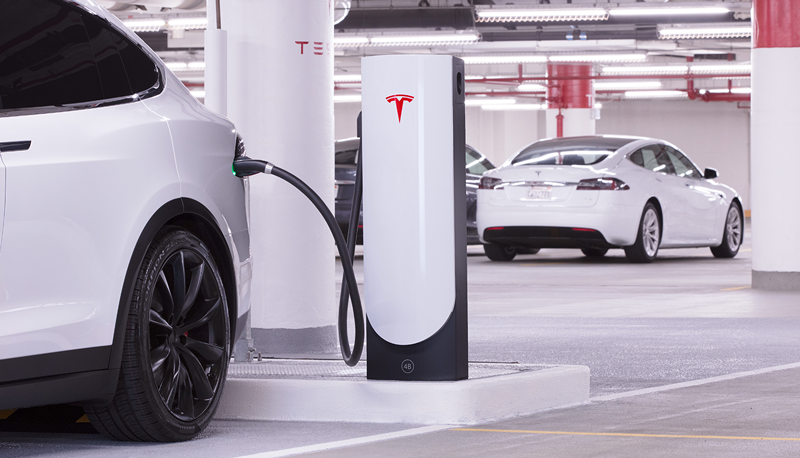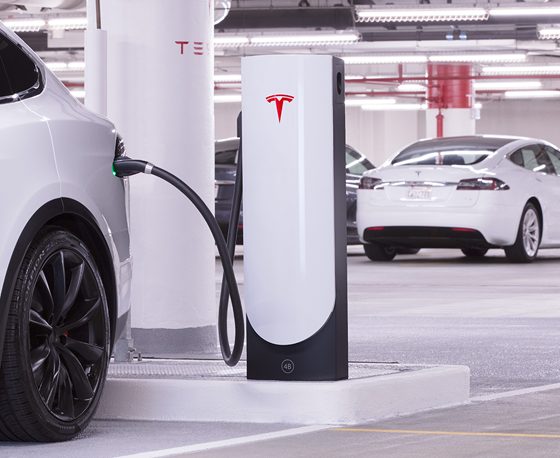

News
Tesla excluded from NY charger incentive program, argues discrimination
Tesla alleges that it’s being discriminated against by the New York state government’s electric vehicle charging cash incentive program. In their march to encourage the transition to clean energy transportation in the consumer market, the state’s Department of Public Service has issued an Order which provides monetary supplements to companies installing publicly accessible EV charging stations. However, the money is only available if both a Combined Charging System (CCS) plug and a CHAdeMo plug are included, not the proprietary charger used by Tesla vehicles. Per the Order:
“Tesla uses its own standard…which the Commission does not recognize as publicly accessible for purposes of this incentive program…Tesla DCFC [direct-current fast charging] stations will become eligible for this per-plug incentive where their proprietary technology is coupled with plug types that enables use by EVs with Asian and European charging systems.”
Governor of New York Andrew Cuomo entered into a “Memorandum of Understanding” with other like-minded governors to reduce the state’s greenhouse gas emissions in October 2013. Specifically, the plan aims to reduce emissions to 40% below 1990 levels by 2030. Part of that initiative includes creating incentives for EV purchases via “Zero-Emission Vehicle” (ZEV) programs to quantify to 800,000 to 1 million ZEVs on state roads by 2025.
Tesla and other EV manufacturers participated in a hearing prior to the Order which resulted in a Consensus Proposal wherein the government and the companies agreed to the conditions of the program. In that Consensus, however, “publicly accessible” was defined as stations available without physical limitations (i.e., exclusive locations) or membership requirements for use. The later-issued Order implementing the program redefined the term “publicly accessible” to include specific types of technology, ultimately excluding Tesla’s proprietary chargers.
Tesla objects to this and has since filed a Petition for Rehearing arguing against the state’s overreach. Per the Petition:
“…without providing any notice of intent to adopt an alternative definition to that set forth in the Consensus Proposal, and without any reasonable record support or rational basis…the Order’s novel definition of ‘publicly accessible’ is unlawful and arbitrary and capricious since it is devoid of record support, lacking a rational basis, and discriminatory.”
The cash incentive program is set to last seven years (2019-2025) and not to exceed 1,074 total stations and/or $28 million dollars provided to participants. To qualify, stations must have charging capability of at least 50 kW, a higher cash incentive being offered for rates over 75 kW. The cash incentive amounts range by regional provider and, according to the Order establishing the charger program, the variance is between $4,000 and $17,000 for the 75 kW stations. With each passing year, the cash incentive amount declines significantly, thus rewarding early birds.
Despite Tesla being the top-selling EV in the country, New York is using its money to vote in favor of a public charging standard, leaving proprietary versions at a disadvantage. Perhaps this wouldn’t seem unusual if Tesla wasn’t arguably the (market-driven) reason New York can dream of such an EV-centered future.
New York has a lot to gain as Tesla continues to bring parity to efficient fueling of electric cars with conventional gas-powered vehicles, especially with the release of its newest 1,000 mi/hr Supercharger V3.

News
Tesla FSD fleet is nearing 7 billion total miles, including 2.5 billion city miles
As can be seen on Tesla’s official FSD webpage, vehicles equipped with the system have now navigated over 6.99 billion miles.

Tesla’s Full Self-Driving (Supervised) fleet is closing in on almost 7 billion total miles driven, as per data posted by the company on its official FSD webpage.
These figures hint at the massive scale of data fueling Tesla’s rapid FSD improvements, which have been quite notable as of late.
FSD mileage milestones
As can be seen on Tesla’s official FSD webpage, vehicles equipped with the system have now navigated over 6.99 billion miles. Tesla owner and avid FSD tester Whole Mars Catalog also shared a screenshot indicating that from the nearly 7 billion miles traveled by the FSD fleet, more than 2.5 billion miles were driven inside cities.
City miles are particularly valuable for complex urban scenarios like unprotected turns, pedestrian interactions, and traffic lights. This is also the difference-maker for FSD, as only complex solutions, such as Waymo’s self-driving taxis, operate similarly on inner-city streets. And even then, incidents such as the San Francisco blackouts have proven challenging for sensor-rich vehicles like Waymos.
Tesla’s data edge
Tesla has a number of advantages in the autonomous vehicle sector, one of which is the size of its fleet and the number of vehicles training FSD on real-world roads. Tesla’s nearly 7 billion FSD miles then allow the company to roll out updates that make its vehicles behave like they are being driven by experienced drivers, even if they are operating on their own.
So notable are Tesla’s improvements to FSD that NVIDIA Director of Robotics Jim Fan, after experiencing FSD v14, noted that the system is the first AI that passes what he described as a “Physical Turing Test.”
“Despite knowing exactly how robot learning works, I still find it magical watching the steering wheel turn by itself. First it feels surreal, next it becomes routine. Then, like the smartphone, taking it away actively hurts. This is how humanity gets rewired and glued to god-like technologies,” Fan wrote in a post on X.
News
Tesla starts showing how FSD will change lives in Europe
Local officials tested the system on narrow country roads and were impressed by FSD’s smooth, human-like driving, with some calling the service a game-changer for everyday life in areas that are far from urban centers.

Tesla has launched Europe’s first public shuttle service using Full Self-Driving (Supervised) in the rural Eifelkreis Bitburg-Prüm region of Germany, demonstrating how the technology can restore independence and mobility for people who struggle with limited transport options.
Local officials tested the system on narrow country roads and were impressed by FSD’s smooth, human-like driving, with some calling the service a game-changer for everyday life in areas that are far from urban centers.
Officials see real impact on rural residents
Arzfeld Mayor Johannes Kuhl and District Administrator Andreas Kruppert personally tested the Tesla shuttle service. This allowed them to see just how well FSD navigated winding lanes and rural roads confidently. Kruppert said, “Autonomous driving sounds like science fiction to many, but we simply see here that it works totally well in rural regions too.” Kuhl, for his part, also noted that FSD “feels like a very experienced driver.”
The pilot complements the area’s “Citizen Bus” program, which provides on-demand rides for elderly residents who can no longer drive themselves. Tesla Europe shared a video of a demonstration of the service, highlighting how FSD gives people their freedom back, even in places where public transport is not as prevalent.
What the Ministry for Economic Affairs and Transport says
Rhineland-Palatinate’s Minister Daniela Schmitt supported the project, praising the collaboration that made this “first of its kind in Europe” possible. As per the ministry, the rural rollout for the service shows FSD’s potential beyond major cities, and it delivers tangible benefits like grocery runs, doctor visits, and social connections for isolated residents.
“Reliable and flexible mobility is especially vital in rural areas. With the launch of a shuttle service using self-driving vehicles (FSD supervised) by Tesla in the Eifelkreis Bitburg-Prüm, an innovative pilot project is now getting underway that complements local community bus services. It is the first project of its kind in Europe.
“The result is a real gain for rural mobility: greater accessibility, more flexibility and tangible benefits for everyday life. A strong signal for innovation, cooperation and future-oriented mobility beyond urban centers,” the ministry wrote in a LinkedIn post.
News
Tesla China quietly posts Robotaxi-related job listing
Tesla China is currently seeking a Low Voltage Electrical Engineer to work on circuit board design for the company’s autonomous vehicles.

Tesla has posted a new job listing in Shanghai explicitly tied to its Robotaxi program, fueling speculation that the company is preparing to launch its dedicated autonomous ride-hailing service in China.
As noted in the listing, Tesla China is currently seeking a Low Voltage Electrical Engineer to work on circuit board design for the company’s autonomous vehicles.
Robotaxi-specific role
The listing, which was shared on social media platform X by industry watcher @tslaming, suggested that Tesla China is looking to fill the role urgently. The job listing itself specifically mentions that the person hired for the role will be working on the Low Voltage Hardware team, which would design the circuit boards that would serve as the nervous system of the Robotaxi.
Key tasks for the role, as indicated in the job listing, include collaboration with PCB layout, firmware, mechanical, program management, and validation teams, among other responsibilities. The role is based in Shanghai.
China Robotaxi launch
China represents a massive potential market for robotaxis, with its dense urban centers and supportive policies in select cities. Tesla has limited permission to roll out FSD in the country, though despite this, its vehicles have been hailed as among the best in the market when it comes to autonomous features. So far, at least, it appears that China supports Tesla’s FSD and Robotaxi rollout.
This was hinted at in November, when Tesla brought the Cybercab to the 8th China International Import Expo (CIIE) in Shanghai, marking the first time that the autonomous two-seater was brought to the Asia-Pacific region. The vehicle, despite not having a release date in China, received a significant amount of interest among the event’s attendees.








